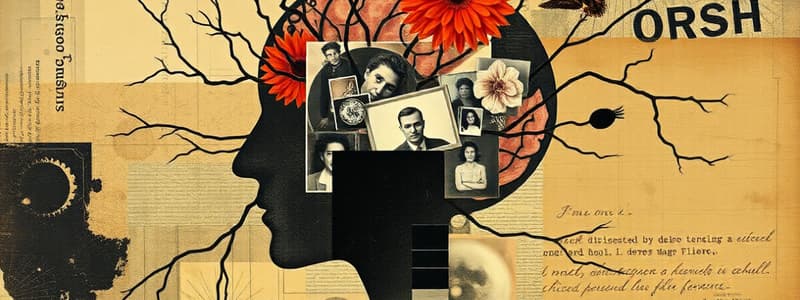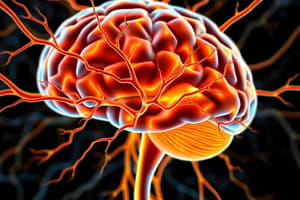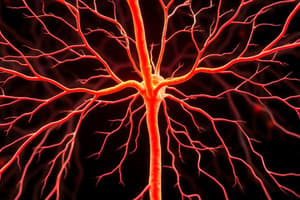Podcast
Questions and Answers
What is the primary function of the sensory neurons within the nervous system?
What is the primary function of the sensory neurons within the nervous system?
- Regulate the activity of internal organs
- Collect and transmit information about the environment (correct)
- Initiate and carry out motor responses
- Process and integrate sensory information
The nervous system is composed of two main divisions. What are they?
The nervous system is composed of two main divisions. What are they?
- Central and peripheral (correct)
- Sympathetic and parasympathetic
- Sensory and motor
- Somatic and autonomic
Which of the following is NOT a function of the central nervous system?
Which of the following is NOT a function of the central nervous system?
- Controlling the contraction of skeletal muscles
- Regulating the secretion of hormones by endocrine glands (correct)
- Monitoring sensory input from both the internal and external environment
- Integrating sensory information and initiating appropriate responses
Which of the following best describes the role of interneurons in the nervous system?
Which of the following best describes the role of interneurons in the nervous system?
Which layer of the meninges is the outermost, tough, and fibrous layer that directly adjoins the skull?
Which layer of the meninges is the outermost, tough, and fibrous layer that directly adjoins the skull?
What is the primary energy source for the central nervous system?
What is the primary energy source for the central nervous system?
The blood-brain barrier plays a crucial role in maintaining the stability of the brain environment. What is its key function?
The blood-brain barrier plays a crucial role in maintaining the stability of the brain environment. What is its key function?
The autonomic nervous system is responsible for regulating involuntary functions. Which of the following is NOT controlled by the autonomic nervous system?
The autonomic nervous system is responsible for regulating involuntary functions. Which of the following is NOT controlled by the autonomic nervous system?
What does the cerebral cortex enable?
What does the cerebral cortex enable?
Which of the following structures are included in each cerebral hemisphere?
Which of the following structures are included in each cerebral hemisphere?
What is the primary function of the motor areas of the cerebral cortex?
What is the primary function of the motor areas of the cerebral cortex?
Which lobe of the brain is primarily responsible for processing visual information?
Which lobe of the brain is primarily responsible for processing visual information?
How does each hemisphere of the brain control the body?
How does each hemisphere of the brain control the body?
What type of matter makes up the majority of the brain's structure?
What type of matter makes up the majority of the brain's structure?
What is the primary role of the somatosensory association cortex?
What is the primary role of the somatosensory association cortex?
Which of the following is NOT a major lobe of the cerebral hemisphere?
Which of the following is NOT a major lobe of the cerebral hemisphere?
Flashcards
Functions of the Nervous System
Functions of the Nervous System
The main roles include monitoring sensory input, integration, and motor output.
Sensory Neurons
Sensory Neurons
Nerve cells that detect stimuli from the environment and send information to the central nervous system.
Interneurons
Interneurons
Nerve cells that process information within the central nervous system and coordinate responses.
Motor Neurons
Motor Neurons
Signup and view all the flashcards
Somatic Nervous System
Somatic Nervous System
Signup and view all the flashcards
Autonomic Nervous System
Autonomic Nervous System
Signup and view all the flashcards
Cerebrospinal Fluid (CSF)
Cerebrospinal Fluid (CSF)
Signup and view all the flashcards
Blood Brain Barrier
Blood Brain Barrier
Signup and view all the flashcards
Cerebral Hemispheres
Cerebral Hemispheres
Signup and view all the flashcards
Gyri and Sulci
Gyri and Sulci
Signup and view all the flashcards
Cerebral Cortex
Cerebral Cortex
Signup and view all the flashcards
Major Lobes of the Brain
Major Lobes of the Brain
Signup and view all the flashcards
Functional Areas of Cerebral Cortex
Functional Areas of Cerebral Cortex
Signup and view all the flashcards
Cerebral White Matter
Cerebral White Matter
Signup and view all the flashcards
Cerebral Gray Matter
Cerebral Gray Matter
Signup and view all the flashcards
Study Notes
Nervous System Organization
- The nervous system collects information from the internal and external environment, processes it, and initiates appropriate responses.
- It has three main functions:
- Monitor sensory input: Sensory neurons detect changes (stimuli) inside and outside the body.
- Integration: Interneurons process sensory information and initiate responses.
- Motor output: Motor neurons send signals to muscles or glands to respond to stimuli.
Nervous System Divisions
- Central Nervous System (CNS): Includes the brain and spinal cord.
- Input: Receives information from sensory organs.
- Output: Sends signals to muscles and glands.
- Peripheral Nervous System (PNS): Connects the CNS to the rest of the body.
- Somatic nervous system: Controls voluntary movements of skeletal muscles.
- Autonomic nervous system: Controls involuntary actions like heart rate and digestion.
- Sympathetic: Prepares the body for vigorous activity.
- Parasympathetic: Calms the body and conserves energy.
- Sensory (Afferent): Carries signals towards the CNS.
- Motor (Efferent): Carries signals away from the CNS.
CNS Protection
- Bone: Cranium (skull) and vertebral column protect the brain and spinal cord.
- Connective Tissue (Meninges): Three layered membranes (dura mater, arachnoid mater, pia mater) surround the brain and spinal cord.
- Fluid (Cerebrospinal Fluid, CSF): Bathes the brain and spinal cord, providing nutrients and removing waste.
CNS Homeostasis and Blood-Brain Barrier
- Cerebrospinal fluid (CSF) is produced, circulated, and absorbed into the venous system.
- Sites of production include the choroid plexus in the ventricles.
- CSF provides buoyancy, removes waste products, and is maintained by a balance of its production and reabsorption.
- The blood-brain barrier (BBB) is a protective mechanism preventing harmful substances from entering the brain.
- It's composed of tight junctions between endothelial cells of brain capillaries.
Cerebral Hemispheres
- The cerebral hemispheres (left and right) make up 83% of the brain's mass.
- They contain ridges (gyri) and grooves (sulci).
- They are separated by the longitudinal fissure.
- Each hemisphere has 3 basic regions: cerebral cortex (gray matter), white matter, and basal nuclei.
Cerebral Lobes
- Deep sulci divide the hemispheres into 5 lobes: frontal, parietal, temporal, occipital, and insula.
Cerebral Cortex
- The cerebral cortex is the outermost layer of the brain.
- It accounts for 40% of the brain's mass.
- It's responsible for higher-level functions like sensation, communication, memory, understanding, and voluntary movements.
- Each hemisphere controls the opposite side of the body (contralateral).
- Hemispheres are not equal in function.
Functional Areas of Cerebral Cortex
- The cerebral cortex has three types of functional areas: motor, sensory, and association areas.
- Motor areas: control voluntary movement.
- Sensory areas: receive and process sensory information.
- Association areas: integrate and process information.
Specific Functional Areas (Examples)
- Primary motor cortex: initiate voluntary movement.
- Premotor cortex: coordinate voluntary movements.
- Prefrontal association areas: planning, thoughts, personality.
- Primary somatosensory cortex: sensory input (touch, pressure, temperature).
- Visual association areas: higher-level visual processing.
- Primary visual cortex: initial visual input.
- Auditory association areas: interpret sounds.
- Primary auditory cortex: initial auditory input.
- Wernicke's area: language comprehension.
- Broca's area: speech formation.
Homunculus
- The amount of cortex devoted to a specific body part correlates with the sensitivity or control needed.
- Parts receiving frequent sensory input or requiring complex movement have a proportionally larger cortical area.
Sensory Areas
- Primary somatosensory cortex: Receives information from skin and skeletal muscles.
- Somatosensory association cortex: Processes sensory input.
- Visual areas: Receives visual information from the eye.
- Auditory areas: Receives sound information.
- Olfactory, gustatory, and vestibular cortices: Responsible for smell, taste, and balance, respectively.
Brain Matter
- Cerebral white matter: Composed primarily of myelinated neurons for fast communication.
- Cerebral gray matter: Contains mainly non-myelinated neurons (such as interneurons) and axon cell bodies for sensory and motor processing.
Gray vs. White Matter
- Gray matter: 40% of the CNS, contains interneurons, synapses.
- White matter: 60% of the CNS, contains myelinated axons.
Studying That Suits You
Use AI to generate personalized quizzes and flashcards to suit your learning preferences.




